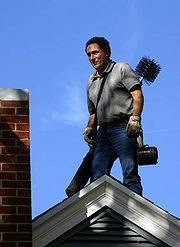
Modern chimney cleaning
Encyclopedia

Heating oil
Heating oil, or oil heat, is a low viscosity, flammable liquid petroleum product used as a fuel for furnaces or boilers in buildings. Home heating oil is often abbreviated as HHO...
, natural gas
Natural gas
Natural gas is a naturally occurring gas mixture consisting primarily of methane, typically with 0–20% higher hydrocarbons . It is found associated with other hydrocarbon fuel, in coal beds, as methane clathrates, and is an important fuel source and a major feedstock for fertilizers.Most natural...
, wood
Wood
Wood is a hard, fibrous tissue found in many trees. It has been used for hundreds of thousands of years for both fuel and as a construction material. It is an organic material, a natural composite of cellulose fibers embedded in a matrix of lignin which resists compression...
and pellet
Pellet stove
A pellet stove is a stove that burns compressed wood or biomass pellets to create a source of heat for residential and sometimes industrial spaces...
burning appliances, including building furnaces and space heaters are maintained by modern chimney sweeps. The standard chimney brush is still used, along with more modern tools (such as vacuums, cameras and special chimney cleaning tools), although most sweeps are done from the bottom of the chimney, rather than the top, to prevent the dispersion of dust and debris.
Most modern chimney sweeps are professionals, and are usually trained to diagnose and repair hazards along with maintenance such as removal of flammable creosote, firebox and damper repair, and smoke chamber repair. Some sweeps also offer more complicated repairs such as flue repair and relining, crown repair, and tuckpointing or rebuilding of masonry chimneys.
In the US, two trade organizations that help to regulate the industry are the Chimney Safety Institute of America and The National Chimney Sweep Guild. Certification for chimney sweeps are issued by two organizations: Certified Chimney Professionals and The Chimney Safety Institute of America. Certification for chimney sweeps who reline chimneys are issued by Certified Chimney Professionals.
In the UK, three trade associations that help to regulate the industry are the National Association of Chimney Sweeps, the Guild of Master Chimney Sweeps and the Association of Professional Independent Chimney Sweeps

